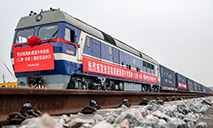China enters new stage of COVID battle amid 2-year high daily tally
China has witnessed the highest daily tally of COVID-19 cases in two years, with numbers soaring to 526 on Sunday, scattered across 14 provinces and municipalities, including several port cities such as Qingdao and densely populated metropolises like Shanghai, as the causes of many sporadic outbreaks remain unknown.
Health experts and officials believed that the frequent, widely-scattered and more concealed infections caused by the Omicron variant are posing more difficulties for China to maintain its "zero-COVID" strategy, but is also propelling China to perfect its current strategy. They believe China has entered a new stage of COVID-19 control, where more precise virus prevention measures are needed to strike a balance between controlling the virus and maintaining normal life.
The experts also noted that the zero-COVID policies will be adjusted in the future when conditions are ripe, when stronger immunological barriers are built, effective medicines emerge, and infection curves outside China are flattened.
China reported 214 new local COVID-19 cases on Sunday, and another 312 local silent carriers of coronavirus. South China's Guangdong Province, which borders the Hong Kong Special Administrative Region where viral spread is rife, reported 69 confirmed cases, the highest in the Chinese mainland. This was followed by Northeast China's Jilin Province with 54 cases, and the port city of Qingdao in East China's Shandong Province with 46 cases.
Lu Hongzhou, the head of Shenzhen's anti-epidemic expert team and head of the Third People's Hospital of Shenzhen, said the rampant infections in Hong Kong in part triggered the outbreak in Guangzhou, as many truck drivers travel between Hong Kong and Guangzhou and some people illegally cross the border between the two regions.
Shenzhen, a city in Guangdong adjoining Hong Kong, rolled out new rules for people entering the city from Hong Kong, saying they must present nucleic acid tests issued by 33 designated institutes, approved by both the Guangdong provincial government and HKSAR government, and have to be nasal swabs, or combined throat and nasal swabs, instead of simply throat swabs, which are prevalent in the Chinese mainland.
There is no clear indication of what caused the infections in Jilin and Qingdao. At a press conference on Monday, Jiang Fachun, deputy head of Qingdao's center for disease control and prevention, said that most new cases in Qingdao are silent carriers of the virus, as they contracted with Omicron variant, which results in milder symptoms, adding that the high vaccination rate has also been effective in fending off severe cases.
Qingdao has put 8,077 people under collective quarantine as of Monday morning. The city of Jilin in Jilin Province announced on Sunday the suspension of work and production, and asked schools to suspend classes.
Shanghai, the poster child in its ability to precisely contain the virus, is also struggling to deal with the latest wave of infections, reporting roughly 16 confirmed cases and dozens of asymptomatic cases this month. Wu Jinglei, director of the Shanghai Municipal Health Commission said at a Monday press conference that a total of 150,000 people have been screened for this outbreak in Shanghai.
Several office and residential buildings in Shanghai are under lockdown. "My company halved the number of employees going to work every day," an employee in Shanghai told the Global Times.
New round of debate
Coupled with the more frequent and widespread infection nationwide is a new round of discussions over China's zero-COVID policy, which has been adopted for more than two years, and is regarded by health experts as the "optimal" way of dealing with the coronavirus in China for now.
During the ongoing two sessions, which kicked off on Friday, the zero-COVID policy has also become a hot topic of discussion for officials and delegates.
China's dynamic zero COVID-19 policy is suited to its national conditions and benefits the world, Guo Weimin, the spokesperson of the fifth session of the 13th National Committee of the Chinese People's Political Consultative Conference, said during a briefing on Thursday.
However, health experts agreed that the dual risk of imported and local cases have pushed China's COVID-19 control to a new stage where more precise measures are needed to strike a better balance of virus prevention and maintaining normal life.
"The current sporadic outbreaks and concealed infections caused by the Omicron variant are posing more challenges for the zero-COVID strategy," a senior official at China's Center for Disease Control and Prevention (CDC) told the Global Times.
"Thus it is important to stick to precise management of the virus, and reduce the impact of virus prevention measures to a minimum."
Given the fact that the Omicron variant spread faster and more surreptitiously than previous variants, Lu suggested that the country put more efforts into tracking infected patients with smart methods once they get infected so as to control the viral transmission route as early as possible and confine the scale of the outbreak to as small an area as possible.
"This kind of precise anti-epidemic method enables epidemic-affected areas to scientifically impose anti-epidemic measures based on the risk of the epidemic. Not only will this deal with the more sneaky Omicron, it will also reduce the negative impact brought by COVID-19 on society and the normal lives of the public to a minimum," Lu told the Global Times.
Experts believed that adjusting COVID-19 policies cannot be interpreted simply as China abandoning the dynamic zero-COVID strategy. "The policy will be adjusted in the future, but it will take time, and the key point is to find the right moment, when conditions are ripe," said the CDC official.
According to a prediction model conducted by a teamled by Huang Jianping from Lanzhou University, if China relaxes restrictive policies, an outbreak that occurs in the country would lead to more than 10 million infections, the Global Times learned from the team on Friday.
The team told the Global Times that, at current stage, China's strategy to prevent the resurgence of a domestic outbreak and imported COVID-19 cases and the dynamic zero-COVID approach are still the best plan to deal with the pandemic.
Zhang Wenhong, a respected infectious disease expert in Shanghai who has been dubbed China's "Anthony Fauci", said he has discussed possible measures and treatments with experts all over the country on possible adjustment of the current strategy. He noted that no matter what kind of strategy China adopts in fighting coronavirus, the bottom line is to prevent a large-scale return of infections and the overwhelming of medical resources.
He said the next stage in COVID-19 prevention should be focused on achieving the best result at minimal cost.
Zhang also stressed the importance of vaccines. After analyzing 2,266 cases in Shanghai for the past half a year, Zhang and his team found that none of them, who are 94 percent vaccinated, had developed into severe or fatal cases.
Lu also suggested widening the use of vaccines in the face of the Omicron variant onslaught, such as nasally inhaled vaccines and mRNA vaccines. He also noted that the country can quicken the approval of domestically-produced nasally inhaled vaccines and mRNA vaccines.
Currently, more than 87 percent of the Chinese population has been vaccinated, most with inactivated vaccines. But Lu said a homologous booster of an inactivated vaccine displayed very limited neutralizing activity against the Omicron variant and its neutralizing activity was significantly lower than that of a heterologous booster or mRNA vaccine alone.
"We can already see the dawn of victory against coronavirus. When the global infection wave ebbs, China, with its medical achievements and social governance ability, can surely explore an innovative way that leads to normal life with a low fatality rate," according to Zhang.
Photos
Related Stories
Copyright © 2022 People's Daily Online. All Rights Reserved.










